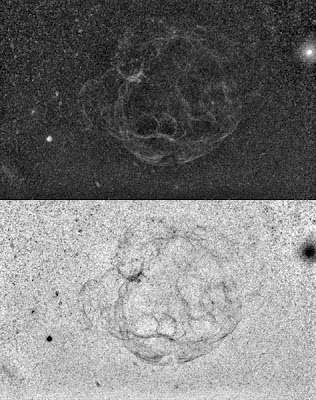COPYRIGHT, PLEASE NOTE
Saturday, March 29, 2008
Sh2-240 with more photons.

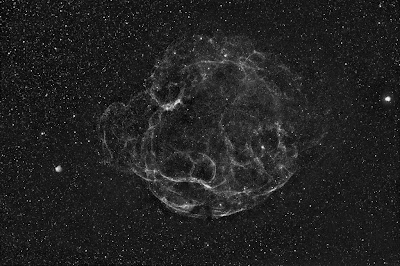
Hydroge alpha channel only
-
Update:
I reprocessed images, and I was able to go litle deeper, I think.
The data is yet "thin" and more exposures are needed, maybe an other ten hours.
Friday, March 28, 2008
Sh2-129
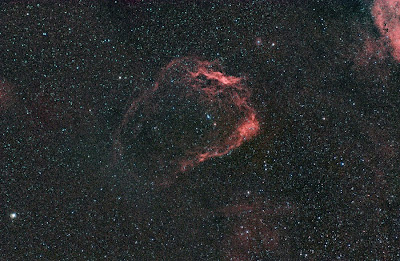

Tuesday, March 25, 2008
IC 1396 in Color
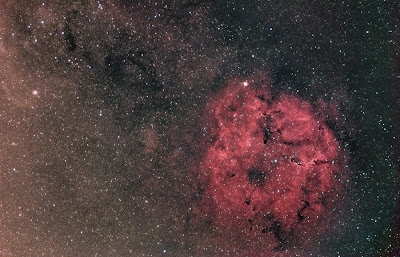
Friday, March 21, 2008
IC 443 & NGC 2175
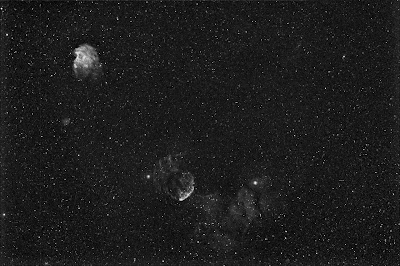
Focusing & imaging system for the camera lens
 Focusing system from top.
Focusing system from top.

image about whole imaging system
 The Business end of the lens
The Business end of the lens
Accurate focusing is needed doe the very fast lens. At f2.8 the sharp focus zone is about 20/1000 mm! Focusing by hand is a pure Lottery. I have TCF-s focuser and its temperature compensated, so thereis no need to refocus every time when temperature drops.
The focusing system has been build from the scrap metal and some parts found from
the drawer.
Its very easy to move the focuser back and forth between main scope
and the lens.
There is a right size can lid bolted down to a L-shape body.
Focuser is then atattched to the lid.
In a focuser, there is a brass tube. This tube goes back and forth when focuser moves.
Its then rotate the focuser ring of the camera lens. There is peace of fine sandpaper glued
to the tube to prevent slipery, tube has allso a spring load for the same purpose.
I have used TCF-s focuser but it can be any focuser, even manual one!
It will make focusing easier and less random.
The whole project took about three hours of time and cost 50c (I had to buy
some bolts)
The whole assembly is then attached to the dowetail rail at top of the LX200 scope.
This is a second version.
The firs version was made by blywood, but I made it again with metal doe flexsure problems.
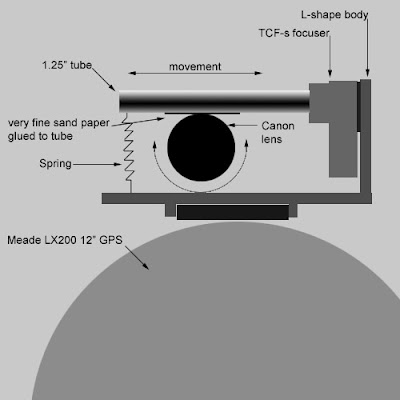 Shematic
Shematic
Thursday, March 20, 2008
IC 1396 & Dark nebulas in Hydrogen Alpha light
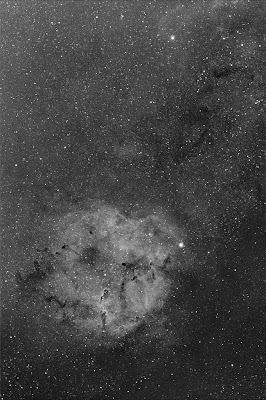 After playing with 3D stuff I returned back to real astro imaging.
Last night was allmost full Moon and doe that I selected the target from opposite side of the sky.
IC 1396 was about 30-36 degrees above horizont during the capturing.
IC 1396 is a large emission nebula. Image scale fits well with field of view
of Canon FD 200mm f2.8 lens. There is lots of faint nebulosity around the field.
Dark nebulas, visible in image, are dark hydrogen clouds and
they are blocking light from background stars.
One part of the large nebula is a famous "Elephant's Trunk Nebula", seen in lower
part of the image.
After playing with 3D stuff I returned back to real astro imaging.
Last night was allmost full Moon and doe that I selected the target from opposite side of the sky.
IC 1396 was about 30-36 degrees above horizont during the capturing.
IC 1396 is a large emission nebula. Image scale fits well with field of view
of Canon FD 200mm f2.8 lens. There is lots of faint nebulosity around the field.
Dark nebulas, visible in image, are dark hydrogen clouds and
they are blocking light from background stars.
One part of the large nebula is a famous "Elephant's Trunk Nebula", seen in lower
part of the image. Elephant's Trunk detail from 10.12.2007
Older image of the "Elephant's Trunk", with longer FL
This formation can be seen in upper image. (lower part of the picture).
LX200 GPS 12" f6.3 + SXV-AO (Active Optics system) H-a 4h Elephants trunk nebula in IC 1396
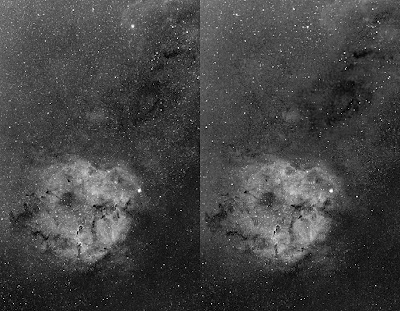 Parallel Vision Stereo Image
Parallel Vision Stereo Image
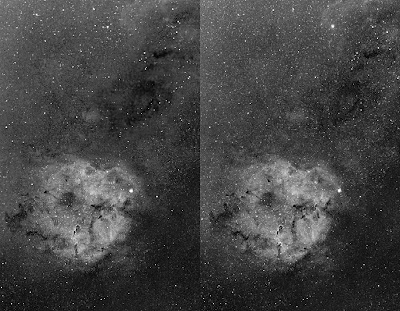 Cross Vision Stereo Image
Cross Vision Stereo Image
Chilifornia Nebula in 3D
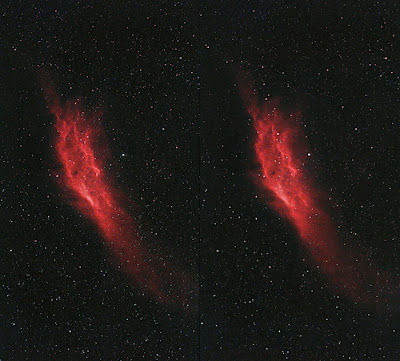
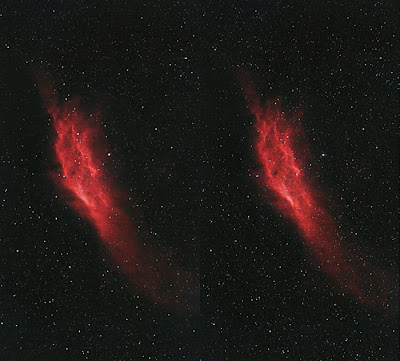
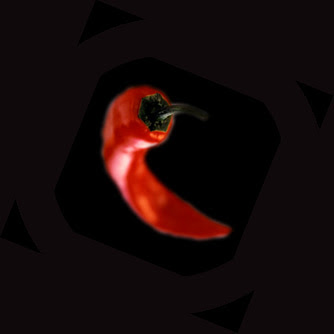
Wednesday, March 19, 2008
3D Bubble Nebula

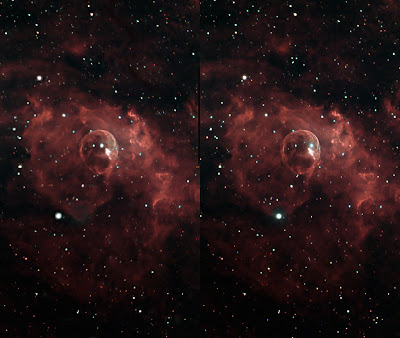
Tuesday, March 18, 2008
M81, 3D transformation
M81, Odd Stereo Pair
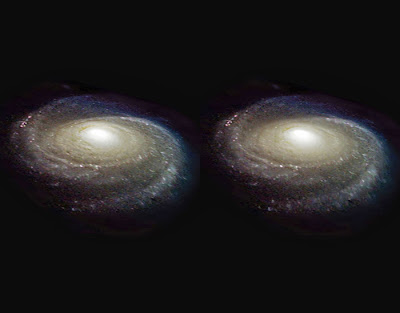
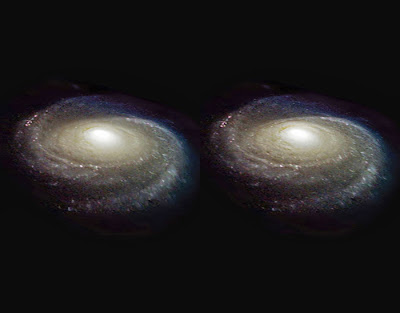
M81 experiment
Veil Nebula, NGC 6995, stereo
 Parallel Vision version
Parallel Vision version
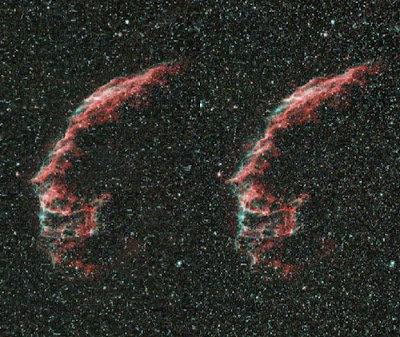 Cross Vision version
The fine filaments really stands out in three dimensional image.
Viewing instructions, please, see previous posts
Cross Vision version
The fine filaments really stands out in three dimensional image.
Viewing instructions, please, see previous posts
Monday, March 17, 2008
IC 1805, Stereo Pair
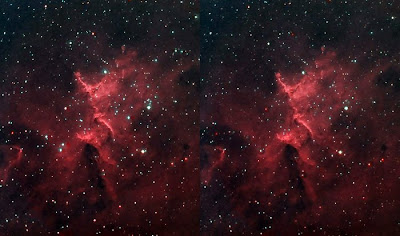
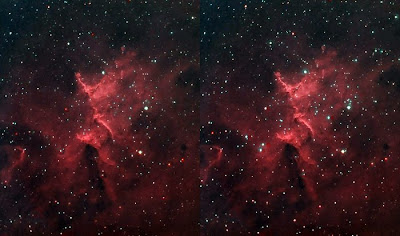 Cross Vision version
This beautiful object in the core of IC1805 nebula and star cluster,
really shines out in stereo.
It feels like more details are visible when both eyes recives visual information
with some angular difference?!?
Viewing istructions, see previous posts.
Cross Vision version
This beautiful object in the core of IC1805 nebula and star cluster,
really shines out in stereo.
It feels like more details are visible when both eyes recives visual information
with some angular difference?!?
Viewing istructions, see previous posts. Rosette Nebula, Stereo pair
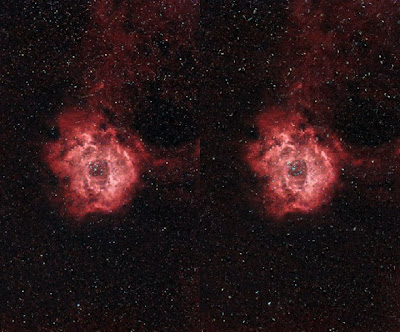
New Stereo Pair technique
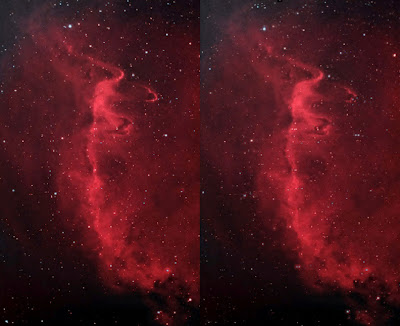
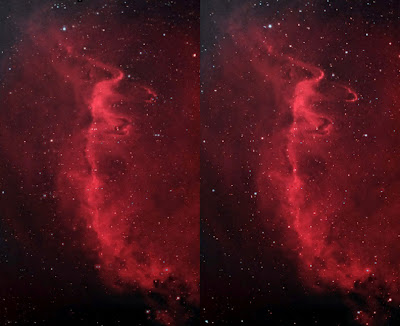 Sample image for Cross Vision method
PARALLEL VISION ISTRUCTIONS:
In parallel freeviewing the image for the left eye is on the left and the image for the right eye is on the right. You stare into the screen so that your eyes are aimed (more or less) parallel. As you stare into the screen you will get double vision as each eye sees the L & R images separately. When you are staring in at the right distance the middle two images will overlap and become 3d. The outer two images will remain and will still be 2d.
Sample image for Cross Vision method
PARALLEL VISION ISTRUCTIONS:
In parallel freeviewing the image for the left eye is on the left and the image for the right eye is on the right. You stare into the screen so that your eyes are aimed (more or less) parallel. As you stare into the screen you will get double vision as each eye sees the L & R images separately. When you are staring in at the right distance the middle two images will overlap and become 3d. The outer two images will remain and will still be 2d. CROSS VISION INSTRUCTIONS: In cross eye freeviewing the image for the left eye is on the right and the image for the right eye is on the left. You stare at a point about 1/2 way to the screen so that your eye's gaze is crossing at the half way point. Thus the left eye sees the correct image which is on the right. As you cross your eyes the image will go double. When your eyes are crossed the correct amount the middle images will overlap and be in 3d. The two outer images will remain and will be in 2d.
Sunday, March 16, 2008
NGC 4216 & friends
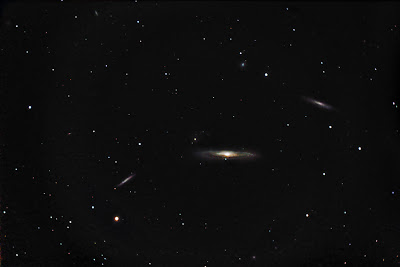 This image is from same night than M51.
In this area, there is so many dim edge on galaxys for some reason.
At the time I shoot this group, the elevation was low, between 24-30 degrees.
That has some effect to the sharpness, but there is still some details visible in central galaxy.
Just above NGC 4216, there is a Bluish object. I was not able to recodnice it. It could
be a comet? At the time span of 2h 45min. it does not appear to move, or it moves very
small amount. (I think there is some minor trailing visible in the closeup image)
Exposures:
11 x 900s = 2h 45min. + Flat and Bias farmes
Telescope:
LX200 GPS 12" + FR f6.4
Guiding:
SXV-AO and LodeStar guider
This image is from same night than M51.
In this area, there is so many dim edge on galaxys for some reason.
At the time I shoot this group, the elevation was low, between 24-30 degrees.
That has some effect to the sharpness, but there is still some details visible in central galaxy.
Just above NGC 4216, there is a Bluish object. I was not able to recodnice it. It could
be a comet? At the time span of 2h 45min. it does not appear to move, or it moves very
small amount. (I think there is some minor trailing visible in the closeup image)
Exposures:
11 x 900s = 2h 45min. + Flat and Bias farmes
Telescope:
LX200 GPS 12" + FR f6.4
Guiding:
SXV-AO and LodeStar guider
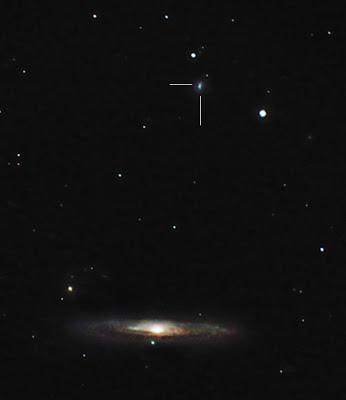 Object I ment in previous text is marked here with lines
UPDATE:
This is fast!
I just uploaded the image to the Cloudy Nights forum and right a way
FrankZ posted information about this object!
"TheSky 6 tells me that this is IC 771 (PGC 39176)!
Type is spiral galaxy. Found in the Catalog of principal galaxies (PGC)."
Thanks a lot Frank!
Object I ment in previous text is marked here with lines
UPDATE:
This is fast!
I just uploaded the image to the Cloudy Nights forum and right a way
FrankZ posted information about this object!
"TheSky 6 tells me that this is IC 771 (PGC 39176)!
Type is spiral galaxy. Found in the Catalog of principal galaxies (PGC)."
Thanks a lot Frank!
Saturday, March 15, 2008
M51, Whirlpool Galaxy
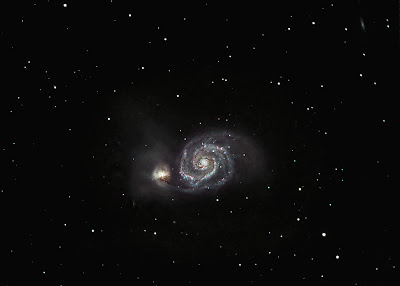
Friday, March 14, 2008
M13, Stereo pair
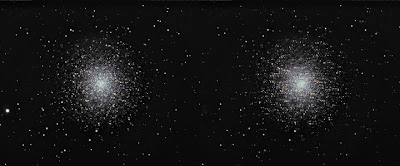
Thursday, March 13, 2008
Sh2-240, Stereo pairs

Sunday, March 9, 2008
M13, second tryout
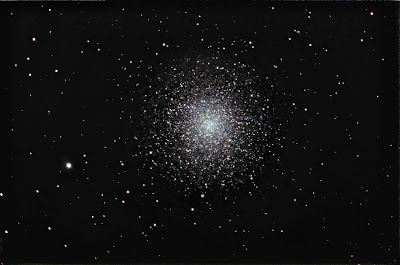
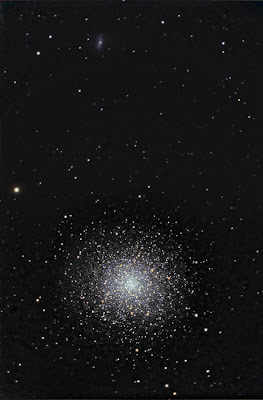
Saturday, March 8, 2008
Sh2-240, four more hours.
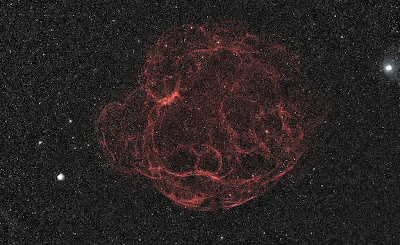
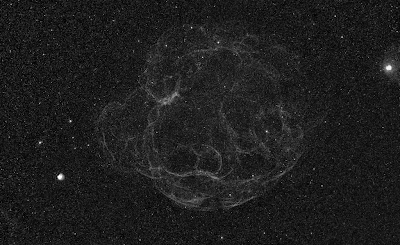
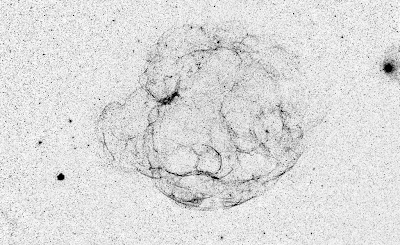 Inverted version
Inverted version Thursday, March 6, 2008
Sh2-240 (Simeis 147)
